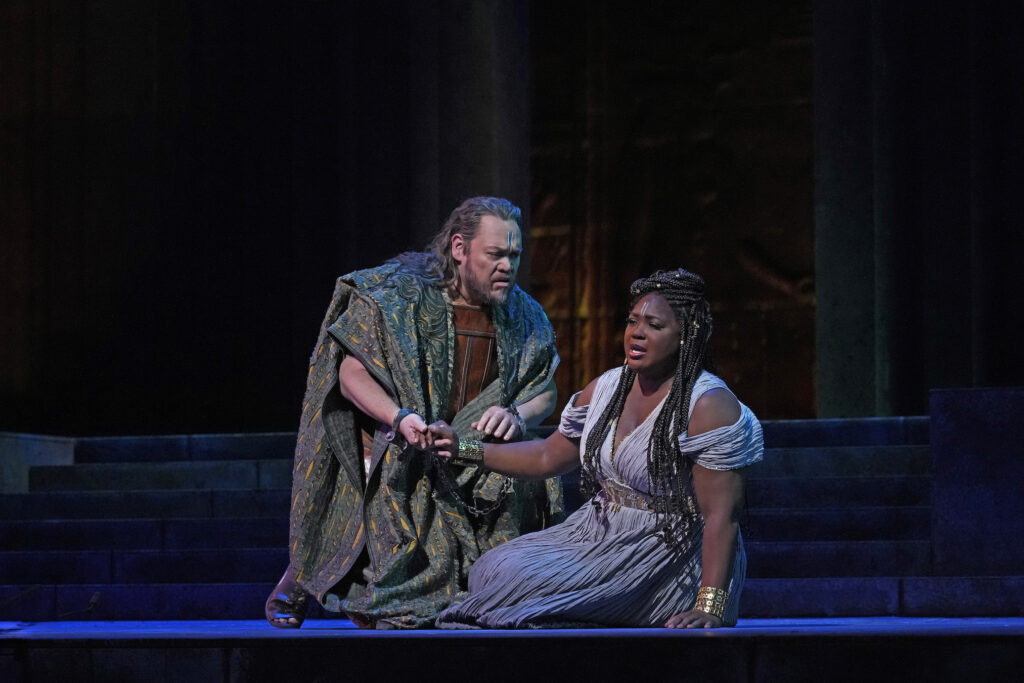THE HANGOVER REPORT – The Met’s new AIDA aims to appease both traditionalists and woke audiences, to mixed results
- By drediman
- January 13, 2025
- No Comments

This past weekend, I made a trip to the Metropolitan Opera to take in the company’s new production of Aida. Having glamorously premiered on New Year’s Eve, Michael Mayer’s anticipated staging of Giuseppe Verdi’s beloved grand opera replaces Sonja Frisell’s epically-scaled 1988 production, which featured monumental physical sets and even a small menagerie of live animals (I have a soft spot for Frisell’s imposing staging, given that it was my first opera experience at the Met). The production’s opening cast is led by company favorite soprano Angel Blue — in her long-awaited company debut as Aida — and the ever-dashing tenor Piotr Beczała as her love interest Radamès. Additionally, Music Director Yannick Nézet-Séguin assumes conducting duties in leading the mighty Met Orchestra.
In short, I would say that Mayer’s staging suffers a bit from an identity crisis, particularly in its endeavor to appease both traditionalists and woke audiences. As the overture commences, Mayer inserts a Hollywood-light prelude depicting an Indiana Jones-like expedition into an archeological site in Egypt, subsequently traveling back in time — in Phantom of the Opera fashion — opening into the opulent world of Verdi’s familiar opera. It’s a well-meaning framing device, especially in its aim to point out these expeditions’ colonial mentality and their blatant appropriation of Egypt’s history and culture. Unfortunately, the overarching conceit is inconsistently applied, often taking viewers out of the captivating human drama at hand (the same can be said of Oleg Glushkov’s derivative, decidedly modern choreography). Otherwise, the production is unimaginative and substantially similar — both in terms of blocking and set designer Christine Jones’s general design concept (the main difference is the incorporation of projection mapping, which brings welcome dynamism to the opera’s often static stage tableaus) — to Frisell’s superior and more visually spectacular staging.
The maiden cast is uneven, at best. In the coveted title role, Blue sounded a tad fatigued the evening I attended the production. Thankfully, her bizarrely inert performance was more than compensated for by the dramatic histrionics of mezzo-soprano Judit Kutasi as Aida’s Egyptian nemesis Amneris. Coming off best was the always reliable baritone Quinn Kelsey (who was so effective in the Met’s otherwise mediocre new Rigoletto) as Amonasro. Beczala fought valiantly through the performance, ultimately delivering a convincingly ardent portrayal. The best aspect of the evening was the sensitive music-making from the pit by Nézet-Séguin and the Met forces. Also particularly fine was the Met Chorus, who sounded magnificent throughout. Aida continues in repertory through the spring with two subsequent casts; hopefully they’re able to inject more compelling life into the new production.
SOMEWHAT RECOMMENDED
AIDA
Opera
The Metropolitan Opera
3 hours, 5 minutes (with one intermission)
In repertory through May 9

 Copyright © 2025
Copyright © 2025
Leave a Reply